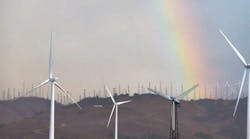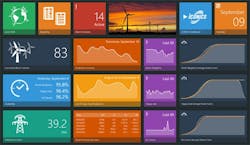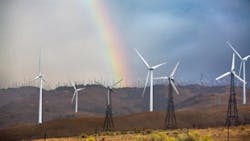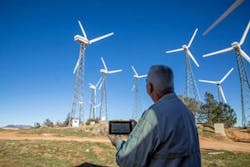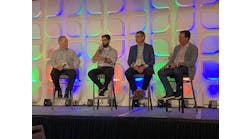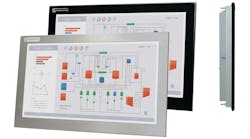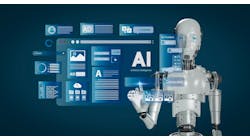In January, Section 201 of the Trade Act of 1974 was used to address concerns raised by solar companies Suniva and SolarWorld Americas, which claimed that less expensive solar cells and modules from foreign markets were undermining their businesses. A 30% import tariff on those solar components was imposed to counteract the flooding of the U.S. market with these cells and modules, allegedly originating from Chinese companies.
Time will tell what impact this might have on the U.S. energy industry and ultimately on the industrial users that consume it to power their manufacturing efforts. Each state has a variety of incentives and policies that drive corporate use of renewable energy. The Database of State Incentives for Renewables & Efficiency (DSIRE) provides access to a comprehensive collection of state-by-state programs that encourage and support energy efficiency and renewables. It’s been around for more than 20 years, is funded by the U.S. Department of Energy and is operated by North Carolina State University’s N.C. Clean Energy Technology Center. While the physical assets behind solar energy surely will be affected in some manner by the new tariff, the machines that run on renewables and other forms of energy will remain relatively unchanged, save for their ability to capture energy data, measure it and report it.
“Detailed running wattage as well as air consumption values are now being requested as part of the quotation process instead of minor details after the order,” says Mike Krummey, electrical engineering manager, Matrix Packing Machinery (www.matrixpm.com), a ProMach company in Saukville, Wisconsin. “This would indicate that end users of packaging equipment are adding this data to the decision-making process. Heavy reliance on renewable energy requires efficient use of all energy, as waste simply cannot be sustained.”
Matrix has always been aware of the high cost of compressed air for its customers. According to the U.S. Department of Energy, compressed air is the largest consumer of electricity in industry on average. “This fact has driven our continued development of electrically operated sealing jaw mechanisms beginning in 2002,” explains Krummey. “Our machines are some of the most efficient in the industry, and that fact has allowed our energy-conscious customers to gain compliance with renewable energy initiatives.”
Where it’s at
“States such as Oregon, Washington, Maine, Idaho, Montana and Iowa are leading the renewable energy charge,” says Arun Sinha, director of business development at Opto 22 (www.opto22.com). “These states and some others though rank higher due to a large component of hydroelectric power. When hydroelectric is removed from the equation, other states that have a high percentage of renewable energy production through sources like wind, solar and geothermal include California, South Dakota, Vermont, Kansas, Minnesota and others.”
Machine builders and system integrators often are now considering energy efficiency in their designs, explains Sinha. “Examples are the use of variable-frequency drives (VFDs) or soft starters and careful motor sizing and selection,” he says. “They are adding value by including power, power quality, current and voltage monitoring onboard the machine so it does not have to be instrumented externally by the customer after the fact. A key requirement going forward is to make sure that this data is available not just to traditional HMI via plant-floor protocols, but also to IT, energy software as a service (SaaS) and IIoT platforms in the data formats they understand.”
These moves toward energy efficiency and data accessibility though may not be related to whether power is originally generated by traditional versus renewable, sources, says Sinha. “Though the end users in some markets may have a choice on where and what type of power they purchase, for the machine builder or system integrator the power is all the same once it is on the demand side of the customer’s utility meter,” he explains.
Clean energy in California usually has to do with solar systems and electric vehicles, says Allen Bennett, application engineer at Allied Electronics & Automation. “The power output of solar systems is growing,” he explains. “The energy collected gets stored in batteries, all made in China. This energy is fed through an inverter to create ac voltage. Larger solar systems will eventually produce enough power to operate a factory in Mexico. Recently, California enacted Rule 21 to govern the operation of inverters and how they work on the grid. Inverter manufacturers had to scramble to apply Rule 21 mandates.”
Electric Rule 21 is a tariff describing the interconnection, operating and metering requirements for generation facilities to be connected to a utility’s distribution system. Customers that wish to install generating or storage facilities on their premises are provided access to the electric grid; Rule 21 protects the safety and reliability of the transmission and distribution systems. Each utility maintains its own version of the rule and is responsible for its administration.
Some facilities are implementing on-site renewable energy sources such as wind and solar, but also cogeneration from things like waste heat, explains Sinha. “One southern California water treatment plant implemented a 1 MW solar installation that on average provides up to 30% of the total plant power,” he says. “After recovery of the initial investment, the resulting operational cost savings can be used toward plant and machinery improvements and upgrades.”
Measure it
“The lure of green and sustainability projects for businesses worldwide has been evident over the past few decades,” says Melissa Topp, senior director of global marketing at Iconics. “While such efforts are noble by themselves, many organizations simultaneously expect to see some return on investment, which requires measurement of their new clean/renewable energy sources.”
In many cases, this involves working with an organization’s existing energy provider to provide the details of the percentage of the supplied electricity from clean sources, such as solar, wind, ocean, hydro, biomass or geothermal. “Some larger enterprises, with the capital to do so, have developed green, renewable energy sources for their own use,” explains Topp. “The largest of these ventures frequently make the news, where a well-known company makes a claim of high-percentage carbon footprint reduction due to on-site solar panels and wind turbines.”
In either of these examples, the organizations still require measured return on investment (ROI), which is where energy management software can be applied (Figure 1). In the first example, a company may be able to receive a data feed or report from the electricity supplier that separates out the percentages of their energy’s origin—coal-powered vs. hydroelectric vs. solar. In the second example, where the company controls the energy source and facility connections, the required data is just as easily attained from connected hardware meters between the source—solar panels or wind turbines—and points of use—where a facility’s equipment gets plugged in.
Figure 1: The organizations still require measured return on investment (ROI), which is where energy management software can be applied.
(Source: Iconics)
“Energy management software can then take that data, whether from utility sources or from on-site generation assets, and help customers further lower their energy costs, reduce consumption and minimize carbon output,” says Topp. “The software aggregates and records consumption data, allowing for continuous analysis and comparison to planned budgets and past performance and validation of utility bills. The use of such energy management software can not only help toward green or sustainability or efficiency efforts in general, but can also help to reduce annual energy costs by up to 25%.”
Figure 2: Facilities that have implemented on-site renewable-generation systems such as wind, solar and fuel cells often tie in data from those sources to the existing plant SCADA system.
(Source: Opto 22)
Traditional automation and data acquisition systems can be used to track the production of renewable or clean energy product with on-site installations, says Opto 22’s Sinha. “Facilities that have implemented on-site renewable-generation systems such as wind, solar and fuel cells often tie in data from those sources to the existing plant SCADA system,” he explains (Figure 2). “There are additional opportunities to use that data, in combination with data from outside sources such as weather, dynamic utility pricing and demand response programs, through the use of IoT-type technologies.”
One specific example on the generation side is SCADA Solutions, a California company that manages wind farms. “SCADA Solutions uses IoT technologies to track utility spot prices to only generate when it is profitable.”
When the California Independent System Operator (CAISO) tells a wind farm operator it needs to curtail energy production, the company can have as little as 5 minutes to respond to the demand. Previously, the utility needed to staff the wind farm 24/7 to physically power the turbines on and off within the required time or else be subject to significant fines.
Figure 3: Remote-monitoring solutions can manage generated energy output on individual wind turbines.
(Source: Opto 22)
With Opto 22’s SNAP PAC industrial controllers managing I/O controllers, a wireless mesh radio network for communications and Opto 22’s Groov interface for mobile devices, SCADA Solutions developed a remote-monitoring solution that could manage generated energy output on each turbine (Figure 3). SCADA Solutions can use analog and digital data. The Opto 22 software application suite provides the ability to push OPC data to the cloud, while the Groov interface lets users access live data and control turbines remotely from a mobile device.
Thirty-five percent of the energy used by Endress+Hauser’s Customer Center and Sales Center on its campus in Greenwood, Indiana, is renewable, as provided by its energy company, says Ben Scher, quality safety manager—operations, Endress+Hauser. “A $1.2-million geothermal system provides the only means of heating and cooling for our Automation and Flowtec production centers,” he explains. “These outputs are the result of a recent campus expansion which included three manufacturing buildings and a customer center, all of which are LEED-certified. There are no current plans for expansion at our U.S. headquarters in Greenwood, but any future expansions will take into consideration the same environmentally conscious guidelines.”
Is it sustainable?
“Renewable energy is an important and responsible topic, but it must be paired with the concept of sustainability,” says Matrix’s Krummey. “A renewable energy device must not cost more in energy than is delivers in its lifecycle. This is a simple idea that bears repeating. If a device consumes more energy to create than it can develop, it is by definition not sustainable. The energy equation simply results in a negative value; it doesn’t matter how you subsidize it financially; it is not a responsible option.”
One other often-debated topic is the use of renewable energy certificates (RECs) in the United States. “RECs are tradable energy commodities that represent proof that 1 megaWatt-hour (MWh) of electricity was generated from an eligible renewable energy source,” explains Opto 22’s Sinha. “They provide a mechanism for the purchase of renewable energy that was added to the electrical grid. RECs are used by an end-user customer or generator to comply with a regulatory requirement or perhaps make a public claim with regard to sustainability or commitment to the environment. Qualified technologies include wind, solar, hydro and fuel cells, among others.”
As a global company, Endress+Hauser is aware of the environmental footprint that it has around the world, says Scher. “Because of this, Endress+Hauser captures key data points from each production-center around the world,” he explains. “This data includes energy and waste consumption, carbon-dioxide emissions and overall waste accumulation. Once this data has been obtained, it is then compared with previous years’ data.”
International companies also require global business meetings and events. “Endress+Hauser is cognizant of these meetings and events, which could cause many employees to have to travel long distances to attend,” explains Scher. “To decrease any travel-related energy consumption and travel emissions, we utilize our vast IT infrastructure to increase our digital-communication capabilities, maximizing our video and teleconferencing as much as possible.”
Endress+Hauser also participates in the annual EcoVadis audit, which allows companies to monitor the sustainability performance of their supply chain. “As more and more of our customers are becoming more in tune with the sustainability of their own entities, they are also basing their decisions and selection processes on those companies who have met the requirements of external auditors, such as EcoVadis,” explains Scher. “Using our score from the EcoVadis audits, we have identified a key strategic indicator that we can utilize year after year to evaluate our supply chain, ethics, social and environmental footprint across the industry.”
As part of Endress+Hauser’s recent campus-wide expansion, four of the buildings are LEED-certified. Some of the environmentally conscious elements that were incorporated into these buildings include:
- all building materials were sourced within a 500-mile radius of the campus
- 87% of all construction waste was recycled
- low volatile organic compounds (low-VOC) carpeting, furniture and building materials were used
- roofs are white thermoplastic polyolefin
- wall systems are double insulated
- glass is low-emissivity thermal
- occupancy sensors control energy-efficient lighting
- skylights amplify manufacturing space lighting
- energy efficiency of all new buildings exceeds the Indiana Energy Code
